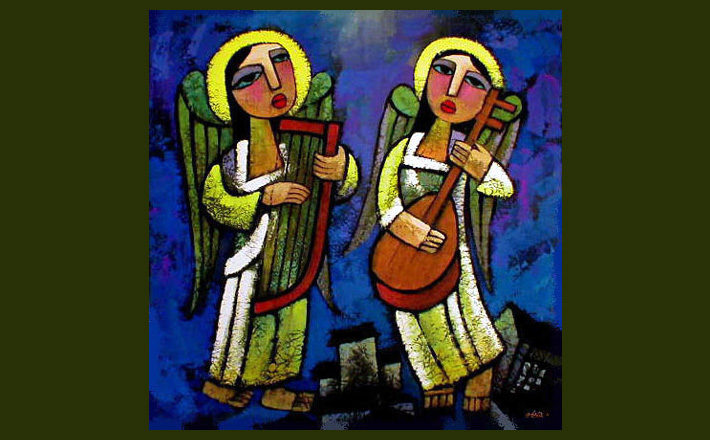Commentary on Luke 7:1-10
Centurions show up rather frequently in the Gospels and in Acts (e.g. Luke 7:2; 23:47; Acts 10:1; cf. Luke 3:14).
This in itself is not surprising, since centurions would have been a part of the Roman occupation force in Judea and Galilee in the first century. What is surprising is that these representatives of Roman occupation are portrayed in quite positive ways in the New Testament and here in Luke 7:1-10. They end up responding to Jesus and his kingdom message with a recognition of his identity and, sometimes, with faith.
The centurion in Luke 7:1-10 fits this surprising profile. He is a Gentile (and presumably Roman, although not all members of the Roman army were ethnically Roman), who seeks Jesus out for the healing of his slave. This oppressor of the Jewish people initiates a conversation with a Jewish healer. He sends Jewish elders to speak on his behalf to Jesus to prove that he has been a patron of the Jewish people (7:3). Then he sends his friends to keep Jesus from coming to his house, expressing confidently and with an analogy from his own role in the Roman army that this Jewish healer, Jesus, is able heal from a distance (7:6-8).
Conversely, Jesus is cast in the unlikely role of responder and not initiator in this passage. When asked to heal the slave, he goes with the Jewish elders (7:6). He responds in amazement at the centurion’s confidence that Jesus needn’t actually come to his house to heal his slave: “I tell you, not even in Israel have I found such faith” (7:9). And finally, Jesus heals the servant, although this is not narrated explicitly (7:10).
Nevertheless, Luke’s reader has been prepared for this surprising portrait of one from the Roman occupation army coming in faith to Jesus for healing. In Luke’s programmatic introduction to Jesus’ ministry (4:16-30), Jesus has preached a message from Isaiah about restoration that references Elisha’s healing of Naaman (2 Kings 5:1-14). Jesus speaks of ‘hometown rejection’ that leads the Old Testament prophet Elisha to heal not the many people in Israel who had leprosy but instead an army commander of Aram, a country hostile to Israel (2 Kings 5:2). And because Elisha heals this Gentile and military enemy, Naaman comes to acknowledge, “there is no God in all the earth except in Israel” (5:15).
Returning to the passage in Luke 7:1-10, the primary characterization that Luke offers of this enemy of Israel is faith that surpasses what Jesus has seen in Israel (7:9). The centurion’s faith is apparent in his understanding of Jesus’ God-given authority to heal and to do so even from a distance. “For I also am a man set under authority, with soldiers under me; and I say to one, ‘Go,’ and he goes, and to another, ‘Come,’ and he comes, and to my slave, ‘Do this,’ and the slave does it” (7:8).
Centurions had a middling role in the hierarchy of the Roman army, put in charge of about 80 soldiers but situated below those who commanded cohorts (consisting of six centuries) and legions (consisting of ten cohorts). The inclusion of “also” at the beginning of verse 8 suggests an analogy between the authority of centurion and Jesus’ authority. As the centurion is given authority from above to command those under him, so the implication is that Jesus has an authority from God that he can enact by simply by saying the word. The centurion’s faith in Jesus’ authority proves to be well placed when Jesus heals his slave without visiting his home (7:10).
Somehow, it seems fitting in this surprising story that Jesus himself is surprised and amazed at the trust this centurion demonstrates (7:9). He is surprised to find faith in a centurion that surpasses what he has seen in anyone from Israel. And we can learn something from Jesus’ own surprise at the specter of an enemy soldier proving to be a model of faith for the people of God. Maybe we should not be surprised by the unlikely places that faith shows up in our own world. It could even show up in those we think are our enemies.
As we preach this passage and drive this point home, we should be careful not to mitigate possible tension arising in our audiences from Jesus healing on behalf of an enemy soldier. If we only highlight the centurion as a person with faith in Jesus, our congregations might miss how surprising this scenario is in Jesus’ (and Luke’s) context. We can remind them that this man, although he has proven to be a friend to the Jewish people by building their synagogue, still represents Roman (enemy) occupation.
Like the people of Nazareth who respond to the story of Elisha and Naaman with anger and rage (4:28), people might respond less than positively if we preach that Jesus cares about, ministers to, and wants to bless our enemies. Moreover, according to this surprising story, God can use those we perceive as our enemies to teach us about true faith. In the end, this story is reminiscent of Jesus’ teaching in Luke 6:27: “Love your enemies, do good to those who hate you.”


June 2, 2013